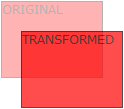CSS3 笔记四(Transforms/Transition/Animations)
CSS3 2D Transforms Methods
translate()rotate()scale()skewX()skewY()matrix()
1> translate()
- The
translate()method moves an element from its current position (according to the parameters given for the X-axis and the Y-axis).

2> rotate()
- The
rotate()method rotates an element clockwise or counter-clockwise according to a given degree.

Example
div {
-ms-transform: rotate(20deg); /* IE 9 */
-webkit-transform: rotate(20deg); /* Safari */
transform: rotate(20deg);
}
3> scale()
- The
scale()method increases or decreases the size of an element (according to the parameters given for the width and height).

4> skewX(沿X轴形变)
- The
skewX()method skews an element along the X-axis by the given angle.
5> skewY(沿Y轴形变)
- The
skewY()method skews an element along the Y-axis by the given angle.
6> skew(沿X和Y轴形变)
- The
skew()method skews an element along the X and Y-axis by the given angles.
7> matrix()
- The
matrix()method combines all the 2D transform methods into one.
Example
div {
-ms-transform: matrix(1, -0.3, 0, 1, 0, 0); /* IE 9 */
-webkit-transform: matrix(1, -0.3, 0, 1, 0, 0); /* Safari */
transform: matrix(1, -0.3, 0, 1, 0, 0);
}
CSS3 3D Transforms
rotateX()rotateY()rotateZ()
1> rotateX()
- The
rotateX()method rotates an element around its X-axis at a given degree.

2> rotateY()
- The
rotateY()method rotates an element around its Y-axis at a given degree.

3> rotateZ()
- The
rotateZ()method rotates an element around its Z-axis at a given degree:
Example
div {
-webkit-transform: rotateZ(90deg); /* Safari */
transform: rotateZ(90deg);
}
CSS3 Transitions
- Specify the CSS property you want to add an effect to.
- Specify the duration of the effect.
Note: If the duration part is not specified, the transition will have no effect, because the default value is 0.
syntax
transition: property duration timing-function delay|initial|inherit;
Example
input[type=text] {
width: 100px;
-webkit-transition: ease-in-out, width .35s ease-in-out; /* Safari 3.1 to 6.0 */
transition: width .35s ease-in-out;
}
input[type=text]:focus {
width: 250px;
}
1> transition-property
- Specify the name of the CSS property
syntax
transition-property: none|all|property|initial|inherit;
Example
div {
-webkit-transition-property: width, height; /* Safari */
transition-property: width, height;
}
div:hover {
width: 300px;
height: 300px;
}
2> transition-duration
- Specifies how many seconds (s) or milliseconds (ms) a transition effect takes to complete.
syntax
transition-duration: time|initial|inherit;
Example
div {
-webkit-transition-duration: 5s; /* Safari */
transition-duration: 5s;
}
3> transition-delay
- The transition-delay property specifies when the transition effect will start.
- The transition-delay value is defined in seconds (s) or milliseconds (ms).
syntax
transition-delay: time|initial|inherit;
Example
div {
-webkit-transition-delay: 2s; /* Safari */
transition-delay: 2s;
}
4> transition-timing-function
- The transition-timing-function property specifies the speed curve of the transition effect.
- This property allows a transition effect to change speed over its duration.
syntax
transition-timing-function: ease|linear|ease-in|ease-out|ease-in-out|cubic-bezier()|initial|inherit;
| Value | Description |
|---|---|
| ease | Default value. Specifies a transition effect with a slow start, then fast, then end slowly (equivalent to cubic-bezier(0.25,0.1,0.25,1)) |
| linear | Specifies a transition effect with the same speed from start to end (equivalent to cubic-bezier(0,0,1,1)) |
| ease-in | Specifies a transition effect with a slow start (equivalent to cubic-bezier(0.42,0,1,1)) |
| ease-out | Specifies a transition effect with a slow end (equivalent to cubic-bezier(0,0,0.58,1)) |
| ease-in-out | Specifies a transition effect with a slow start and end (equivalent to cubic-bezier(0.42,0,0.58,1)) |
| cubic-bezier(n,n,n,n) | Define your own values in the cubic-bezier function. Possible values are numeric values from 0 to 1 |
| initial | Sets this property to its default value. |
| inherit | Inherits this property from its parent element. |
Example
/* For Safari 3.1 to 6.0 */
#div1 {-webkit-transition-timing-function: linear;}
#div2 {-webkit-transition-timing-function: ease;}
#div3 {-webkit-transition-timing-function: ease-in;}
#div4 {-webkit-transition-timing-function: ease-out;}
#div5 {-webkit-transition-timing-function: ease-in-out;} /* Standard syntax */
#div1 {transition-timing-function: linear;}
#div2 {transition-timing-function: ease;}
#div3 {transition-timing-function: ease-in;}
#div4 {transition-timing-function: ease-out;}
#div5 {transition-timing-function: ease-in-out;}
CSS3 Animations
1> animation
syntax
animation: name duration timing-function delay iteration-count direction fill-mode play-state;
Example
div {
-webkit-animation: mymove 5s infinite; /* Chrome, Safari, Opera */
animation: mymove 5s infinite;
}
2> animation-name
- The animation-name property specifies a name for the @keyframes animation.
syntax
animation-name: keyframename|none|initial|inherit;
Example
/* The animation code */
@keyframes mymove {
from {background-color: red;}
to {background-color: yellow;}
} /* The element to apply the animation to */
div {
width: 100px;
height: 100px;
background-color: red;
animation-name: mylove;
animation-duration: 4s;
}
3> animation-duration
syntax
animation-duration: time|initial|inherit;
4> animation-timing-function
syntax
animation-timing-function: linear|ease|ease-in|ease-out|cubic-bezier(n,n,n,n)|initial|inherit;
5> animation-delay
syntax
animation-delay: time|initial|inherit;
6> animation-iteration-count
- The animation-iteration-count property specifies the number of times an animation should be played.
syntax
animation-iteration-count: number|infinite|initial|inherit;
7> animation-direction
syntax
animation-direction: normal|reverse|alternate|alternate-reverse|initial|inherit;
?? 8> animation-fill-mode
- The animation-fill-mode property specifies a style for the element when the animation is not playing (when it is finished, or when it has a delay).
syntax
animation-fill-mode: none|forwards|backwards|both|initial|inherit;
9> animation-play-state
- The animation-play-state property specifies whether the animation is running or paused.
syntax
animation-play-state: paused|running|initial|inherit;
Example
div {
width: 100px;
height: 100px;
background: red;
position: relative;
-webkit-animation: mymove 5s infinite; /* Chrome, Safari, Opera */
animation: mymove 5s infinite;
}
div:hover {
-webkit-animation-play-state: paused; /* Chrome, Safari, Opera */
animation-play-state: paused;
}
/* Chrome, Safari, Opera */
@-webkit-keyframes mymove {
from {left: 0px;}
to {left: 200px;}
}
@keyframes mymove {
from {left: 0px;}
to {left: 200px;}
}
</style>
Animation example1
div {
animation: example 5s linear 2s infinite alternate;
}
Animation example2
<!DOCTYPE html>
<html>
<head>
<style>
div {
width: 100px;
height: 100px;
background-color: red;
position: relative;
animation-name: example;
animation-duration: 5s;
animation-timing-function: linear;
animation-delay: 2s;
animation-iteration-count: infinite;
animation-direction: alternate;
}
@keyframes example {
0% {background-color:red; left:0px; top:0px;}
25% {background-color:yellow; left:200px; top:0px;}
50% {background-color:blue; left:200px; top:200px;}
75% {background-color:green; left:0px; top:200px;}
100% {background-color:red; left:0px; top:0px;}
}
</style>
</head>
<body> <p><b>Note:</b> This example does not work in Internet Explorer 9 and earlier versions.</p> <div></div> </body>
</html>
CSS3 笔记四(Transforms/Transition/Animations)的更多相关文章
- IE10开始支持CSS3 Transitions, Transforms 和 Animations
这是一个好消息,微软公开说明IE10预览版已经支持CSS3属性 Transitions, Transforms 和 Animations,你可以直接写transitions,而不是加个恶心的前缀-ms ...
- css笔记——区分css3中的transform transition animation
出处:http://blog.csdn.net/dyllove98/article/details/8957232 CSS3中和动画有关的属性有三个 transform. transition ...
- C#可扩展编程之MEF学习笔记(四):见证奇迹的时刻
前面三篇讲了MEF的基础和基本到导入导出方法,下面就是见证MEF真正魅力所在的时刻.如果没有看过前面的文章,请到我的博客首页查看. 前面我们都是在一个项目中写了一个类来测试的,但实际开发中,我们往往要 ...
- 《MFC游戏开发》笔记四 键盘响应和鼠标响应:让人物动起来
本系列文章由七十一雾央编写,转载请注明出处. http://blog.csdn.net/u011371356/article/details/9327377 作者:七十一雾央 新浪微博:http:// ...
- IOS学习笔记(四)之UITextField和UITextView控件学习
IOS学习笔记(四)之UITextField和UITextView控件学习(博客地址:http://blog.csdn.net/developer_jiangqq) Author:hmjiangqq ...
- java之jvm学习笔记四(安全管理器)
java之jvm学习笔记四(安全管理器) 前面已经简述了java的安全模型的两个组成部分(类装载器,class文件校验器),接下来学习的是java安全模型的另外一个重要组成部分安全管理器. 安全管理器 ...
- Java学习笔记四---打包成双击可运行的jar文件
写笔记四前的脑回路是这样的: 前面的学习笔记二,提到3个环境变量,其中java_home好理解,就是jdk安装路径:classpath指向类文件的搜索路径:path指向可执行程序的搜索路径.这里的类文 ...
- Java加密与解密笔记(四) 高级应用
术语列表: CA:证书颁发认证机构(Certificate Authority) PEM:隐私增强邮件(Privacy Enhanced Mail),是OpenSSL使用的一种密钥文件. PKI:公钥 ...
- Learning ROS for Robotics Programming Second Edition学习笔记(四) indigo devices
中文译著已经出版,详情请参考:http://blog.csdn.net/ZhangRelay/article/category/6506865 Learning ROS for Robotics Pr ...
随机推荐
- (绝对官方好用,快速上手)针对grunt之前写的那篇有些乱,这次总结个清晰的
安装 Grunt基于Node.js,安装之前要先安装Node.js,然后运行下面的命令. sudo npm install grunt-cli -g grunt-cli表示安装的是grunt的命令行界 ...
- php上传大文件时,服务器端php.ini文件中需要额外修改的选项
几个修改点: 1.upload_max_filesize 上传的最大文件 2.post_max_size 上传的最大文件 3.max_execution_time 修改为0表示无超时,一直等待 4.m ...
- c#解析xml
贴代码 xml <?xml version="1.0" encoding="utf-8" ?> <CoInfo Name="Bota ...
- Hyper-V~双网卡设置
Windows: Win10 有线网卡+无线网卡各一块 Hyper-V: 10.0.10240.16384 公司网络服务器180网段,公网192.168.0.*网段 家里网络:192.168.1.*网 ...
- sql入门基础
好用的mysql客户端 https://www.quora.com/What-is-the-best-free-DB-schema-design-tool https://www.quora.com/ ...
- mysql 使用函数
delimiter $$ CREATE FUNCTION my_replace(in_string VARCHAR(255),in_find_str VARCHAR(20),in_repl_str V ...
- sql server 存储过程 以及java如何使用存储过程
Sql 语句 有一个test_table1表 他有两个字段 ID 和name proc是procedure的缩写 也就是存储过程,StuProc2为创建的存储过程名称 执行以下创建存储后会在Sql ...
- css基础知识
CSS 规则由两个主要的部分构成:选择器,以及一条或多条声明.其中选择器通常是您需要改变样式的 HTML 元素(比如p标签),也可以是节点的属性的值(比如id,class):每条声明都是一条字典key ...
- 数据库访问CRUD;__SELF__和__ACTION__的区别;自动收集表单:$n->create();
一.tp框架数据访问(pdo基础) public function test() { $n = D("Nation"); //select();find(); //查询 1.$at ...
- js自定义弹出框
js自定义弹出框: 代码如下 <html> <head><title>自定义弹出对话框</title> <style type ="te ...
